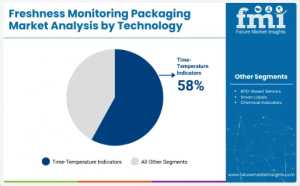Freshness Monitoring Packaging Rises with Sensors, TTIs, and Tech Demand in Perishables and Global Food Safety Push
Global market to hit USD 1.4 billion by 2035, growing at 7.2% CAGR as smart packaging tech helps cut food waste and boost traceability in perishable goods.
NEWARK, DE, UNITED STATES, August 4, 2025 /EINPresswire.com/ -- The global freshness monitoring packaging market is projected to reach USD 1.4 billion by 2035, reflecting a Compound Annual Growth Rate (CAGR) of 7.2%. This robust growth is fueled by the critical need to reduce food waste, enhance food safety, and increase supply chain transparency for perishable goods.
The market, which holds a 5-8% share of the smart food packaging segment, is becoming an indispensable tool for businesses and consumers alike. As industries face stricter regulations and consumer demands for greater transparency, the integration of on-package sensors is accelerating. A key example of this innovation came in April 2024, when an Auburn University researcher was awarded a U.S. patent for a novel gas-sensing coating that allows packaging stickers to change color, providing a clear visual indicator of meat freshness.
Technology and End-Use Leaders
The market’s expansion is heavily driven by the dominance of specific segments. Time-temperature indicators (TTIs) are set to maintain their leadership in the technology segment, commanding a 58% share in 2025. Their popularity stems from their affordability, proven accuracy in monitoring thermal history, and seamless integration into existing packaging lines. Leading suppliers like DeltaTrak Inc. and Timestrip UK are enhancing these indicators with multi-threshold and digital readouts to provide more precise data.
In terms of application, the fresh produce segment will lead end-use demand with a 42% share in 2025. The high perishability of fruits and vegetables, coupled with stringent quality requirements, makes this segment a prime adopter of freshness monitoring solutions. Companies such as 3M and Zebra Technologies are partnering with major supermarket chains to deploy these technologies, providing real-time spoilage alerts that help reduce waste and optimize inventory.
Materials and Market Dynamics
Plastic films will remain the dominant material, holding a 37.2% share in 2025. Their ability to balance flexibility, barrier performance, and sensor compatibility makes them the preferred choice for embedding sensors without compromising product integrity. With a growing focus on environmental responsibility, manufacturers are increasingly innovating with recyclable and compostable film substrates to meet evolving consumer and regulatory demands.
The market's growth is fundamentally driven by rising regulatory pressures and consumer demand for transparency. Government food-safety mandates, particularly in regions like the EU, the U.S., and Asia, are prompting the widespread adoption of monitoring technologies. This push for greater traceability and documentation is a key driver.
However, the market faces challenges, including high sensor costs and the complexity of integrating new technology into existing infrastructure. These barriers disproportionately affect smaller producers with limited capital. To overcome this, suppliers are offering modular, pilot-ready systems, though full scalability remains a key challenge for the industry.
Asia Pacific Leads Regional Growth
The market’s global growth trajectory is most pronounced in the Asia Pacific region. South Korea is projected to have the highest CAGR of 8.6% from 2025 to 2035, fueled by a tech-savvy consumer base, a robust e-commerce sector, and government-supported cold chain digitization. India is also experiencing rapid growth with a projected 7.3% CAGR, driven by government infrastructure projects, rising disposable incomes, and the urgent need to address high post-harvest losses.
Developed markets are also expanding steadily. The United States market is expected to grow at a 7.2% CAGR, led by stringent FDA and USDA guidelines and major retailers piloting RFID-based sensors. The United Kingdom (6.5% CAGR) is seeing steady growth, supported by food safety standards and government initiatives to reduce food waste.
Request Freshness Monitoring Packaging Market Draft Report: https://www.futuremarketinsights.com/reports/sample/rep-gb-22374
For more on their methodology and market coverage, visit! https://www.futuremarketinsights.com/about-us
Competitive Landscape and Strategic Collaborations
The competitive landscape is defined by key players such as FreshTrackTech, 3M, Zebra Technologies Corp., and Timestrip UK LTD. These companies are maintaining their competitive edge through continuous R&D and strategic collaborations. For instance, in October 2024, Avery Dennison announced a major partnership with Kroger to deploy RFID-enabled freshness sensors across its grocery network, a move that signals a significant step toward widespread adoption. Similarly, the June 2025 partnership between Timestrip UK Ltd. and Holtronic Ltd. to launch a new multi-threshold temperature indicator for both blood products and foods highlights the industry’s shift toward integrated sensor networks and advanced chemistries.
As the industry matures, strategic partnerships and continuous innovation will be essential for creating scalable, intelligent packaging systems that can meet the evolving demands of a global market focused on safety, efficiency, and sustainability.
Explore Related Insights
Freshness Indicator Label Market: https://www.futuremarketinsights.com/reports/freshness-indicator-labels-market
Temperature and Freshness Sensors Market: https://www.futuremarketinsights.com/reports/temperature-and-freshness-sensors-market
Monitoring Tool Market: https://www.futuremarketinsights.com/reports/monitoring-tool-market
Editor’s Note:
This release is based exclusively on verified and factual market content derived from industry analysis by Future Market Insights. No AI-generated statistics or speculative data have been introduced. This press release highlights significant shifts in the Freshness Monitoring Packaging market, which is experiencing a pivotal change driven by consumer demand for healthier, more transparent products.
Rahul Singh
Future Market Insights Inc.
+18455795705 ext.
email us here
Visit us on social media:
Other
Legal Disclaimer:
EIN Presswire provides this news content "as is" without warranty of any kind. We do not accept any responsibility or liability for the accuracy, content, images, videos, licenses, completeness, legality, or reliability of the information contained in this article. If you have any complaints or copyright issues related to this article, kindly contact the author above.
Comprehensive Report on the Plant-Based Protein Market: Opportunities and Challenges
Pea Protein Ingredients Industry Report: Competitive Landscape and Future Prospects
Food Preservatives Market Trends and Analysis by Application, Vertical, Region, and Segment Forecast to 2029
Więcej ważnych informacji
 Jedynka Newserii
Jedynka Newserii

 Jedynka Newserii
Jedynka Newserii

Polityka

D. Joński: Nie wiemy, co zrobi Rosja za dwa–trzy lata. Według duńskiego wywiadu może zaatakować kraje nadbałtyckie i musimy być na to gotowi
Zdecydowana większość krajów unijnych wskazuje na potrzebę wzmocnienia zdolności obronnych Europy w obliczu coraz bardziej złożonego geopolitycznego tła. Wywiady zachodnich państw wskazują, że Rosja może rozpocząć konfrontację z NATO jeszcze przed 2030 rokiem. Biała księga w sprawie obronności europejskiej „Gotowość 2030” zakłada m.in. ochronę granic lądowych, powietrznych i morskich UE, a sztandarowym projektem ma być Tarcza Wschód. – W budzeniu Europy duże zasługi ma polska prezydencja – ocenia europoseł Dariusz Joński.
Transport
Duże magazyny energii przyspieszą rozwój transportu niskoemisyjnego w Europie. Przyszłością może być wodór służący jako paliwo i nośnik energii

Zmiany w europejskim transporcie przyspieszają. Trendem jest elektromobilność, zwłaszcza w ramach logistyki „ostatniej mili”. Jednocześnie jednak udział samochodów w pełni elektrycznych w polskich firmach spadł z 18 do 12 proc., co wpisuje się w szerszy europejski trend spowolnienia elektromobilności. Główne bariery to ograniczona liczba publicznych stacji ładowania, wysoka cena pojazdów i brak dostępu do odpowiedniej infrastruktury. – Potrzebne są odpowiednio duże magazyny taniej energii. Przyszłością przede wszystkim jest wodór – ocenia Andrzej Gemra z Renault Group.
Infrastruktura
W Polsce w obiektach zabytkowych wciąż brakuje nowoczesnych rozwiązań przeciwpożarowych. Potrzebna jest większa elastyczność w stosowaniu przepisów

Pogodzenie interesów konserwatorów, projektantów, inwestorów, rzeczoznawców i służby ochrony pożarowej stanowi jedno z największych wyzwań w zakresie ochrony przeciwpożarowej obiektów konserwatorskich. Pożary zabytków takich jak m.in. katedra Notre-Dame w Paryżu przyczyniają się do wprowadzania nowatorskich rozwiązań technicznych w zakresie ochrony przeciwpożarowej. W Polsce obowiązuje już konieczność instalacji systemów detekcji. Inwestorzy często jednak rezygnują z realizacji projektów dotyczących obiektów zabytkowych z uwagi na zmieniające się i coraz bardziej restrykcyjne przepisy czy też względy ekonomiczne.
Partner serwisu
Szkolenia

Akademia Newserii
Akademia Newserii to projekt, w ramach którego najlepsi polscy dziennikarze biznesowi, giełdowi oraz lifestylowi, a także szkoleniowcy z wieloletnim doświadczeniem dzielą się swoją wiedzą nt. pracy z mediami.





![Nestlé w Polsce podsumowuje wpływ na krajową gospodarkę. Firma wygenerowała 0,6 proc. polskiego PKB [DEPESZA]](https://www.newseria.pl/files/1097841585/fabryka-nesquik_1,w_85,r_png,_small.png)




.gif)

 |
| |
| |
|